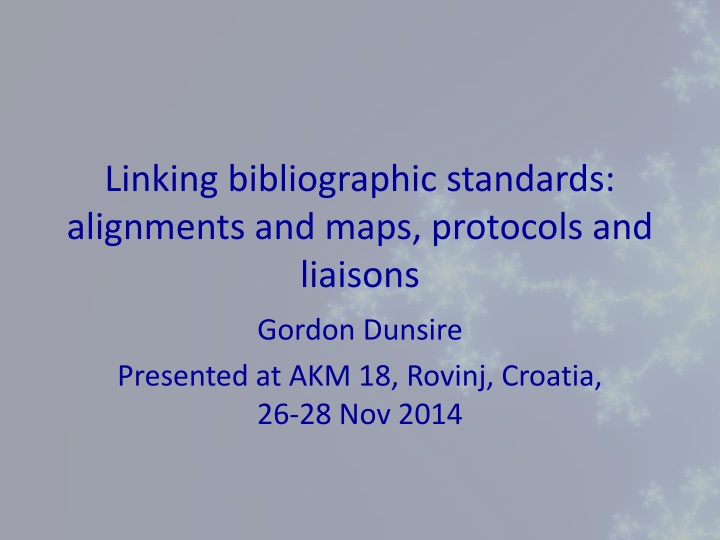
Bibliographic Standards and Protocol Alignment in Information Systems
Explore the intersection of bibliographic standards, protocol alignment, and semantic mapping for efficient information system interoperability. Learn about the importance of element alignment, joint development protocols, and semantic mapping techniques in ensuring harmonization between data produced according to different metadata rules.
Download Presentation

Please find below an Image/Link to download the presentation.
The content on the website is provided AS IS for your information and personal use only. It may not be sold, licensed, or shared on other websites without obtaining consent from the author. If you encounter any issues during the download, it is possible that the publisher has removed the file from their server.
You are allowed to download the files provided on this website for personal or commercial use, subject to the condition that they are used lawfully. All files are the property of their respective owners.
The content on the website is provided AS IS for your information and personal use only. It may not be sold, licensed, or shared on other websites without obtaining consent from the author.
E N D
Presentation Transcript
Linking bibliographic standards: alignments and maps, protocols and liaisons Gordon Dunsire Presented at AKM 18, Rovinj, Croatia, 26-28 Nov 2014
Acting locally Universal Bibliographic Control Thinking globally KOS++ Confusing tongues? RDF FR: Functional Requirements BIBFRAME: Bibliographic Framework ISBD: International Standard Bibliographic Description Say what we mean DC: Dublin Core BibO: Bibliographic Ontology RDA: Resource Description and Access CRM: Conceptual Reference Model MARC21 schema.org UNIMARC
ISBD: RDA: Content form? Content type? A categorization reflecting the fundamental form of communication in which the content is expressed and the human sense through which it is intended to be perceived. A category that reflects the fundamental form or forms in which the content is expressed. Resource Expression
Do you mean what I mean? Communication protocol Alignment of concepts Mapping of vocabularies Continuing interoperability
Protocol Joint Steering Committee for Development of RDA 2014 ISBD Review Group JSC liaison on ISBD RG Publication of shared documents Advance notification of changes Joint development of element alignments
Element alignment enable harmonization between data produced according to the ISBD or RDA metadata content rules Version 3.0 (August 2014) Alignment values: narrower (<), broader (>), same (=) < Content form (ISBD) Content type (RDA)
Semantic mapping RDF (Resource Description Framework) Schema ontology Alignment Mapping A < B A > B A rdfs:subPropertyOf B . B rdfs:subPropertyOf A . Terse triple language (ttl turtle ) A = B A rdfs:subPropertyOf B . B rdfs:subpropertyOf A . isbdu:P1001 rdfs:subPropertyOf rdau:P60049 . Unconstrained elements (not constrained to entities)
Mapping entities rda: Work isbd:P1193 (has work aspect ) bf: expressionOf rdae:P20231 (has work expressed) isbd:P1190 (has expression aspect ) rda: bf: ? Expression Work rdam:P30139 (has expression manifested) bf: instanceOf marc21: Resource isbd: Resource rda: bf: Manifestation Instance isbd:P1192 (has manifestation aspect ) rdai:P40049 (has manifestation exemplified) rda: Item isbd:P1191 (has item aspect )
RDA/ONIX Framework For Resource Categorization Mapping values has Character rofch: language rofsm: hearing has Sensory mode isbdcf: rdact: <===================> spoken word spoken word rofid: n/a has Image dimensionality rofim: n/a has Image movement
Conclusion Semantic mappings support interoperability of linked data Mappings require alignments Both sides must agree and maintain alignments and mappings Maintenance requires protocol
Thank you! gordon@gordondunsire.com Michaelangelo, Creation of Adam, Sistine Chapel, 1511-1512 Pieter Bruegel the Elder, The Tower of Babel, 1563 Jan van Eyck, Portrait of Giovanni Arnolfini and his Wife, 1434
